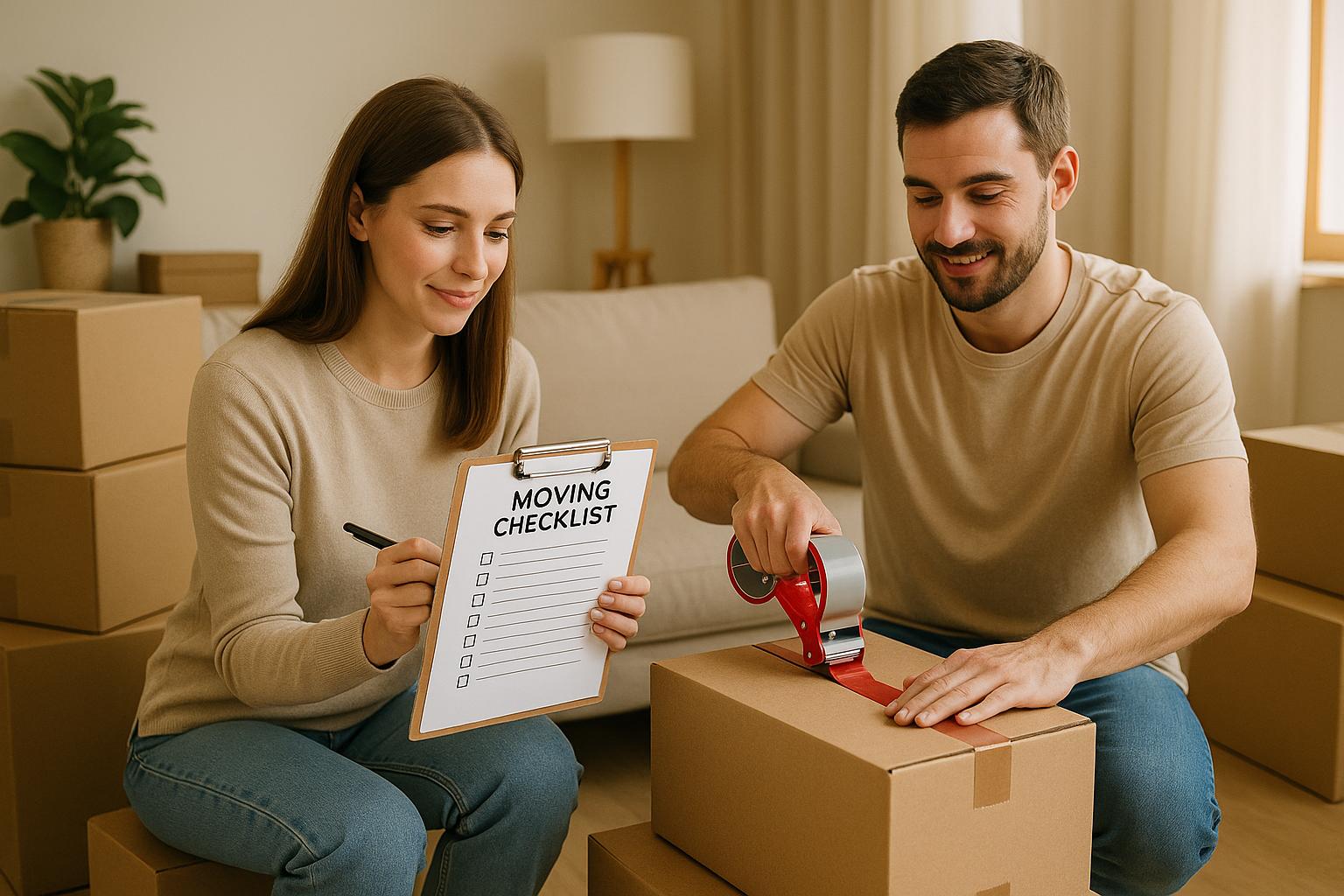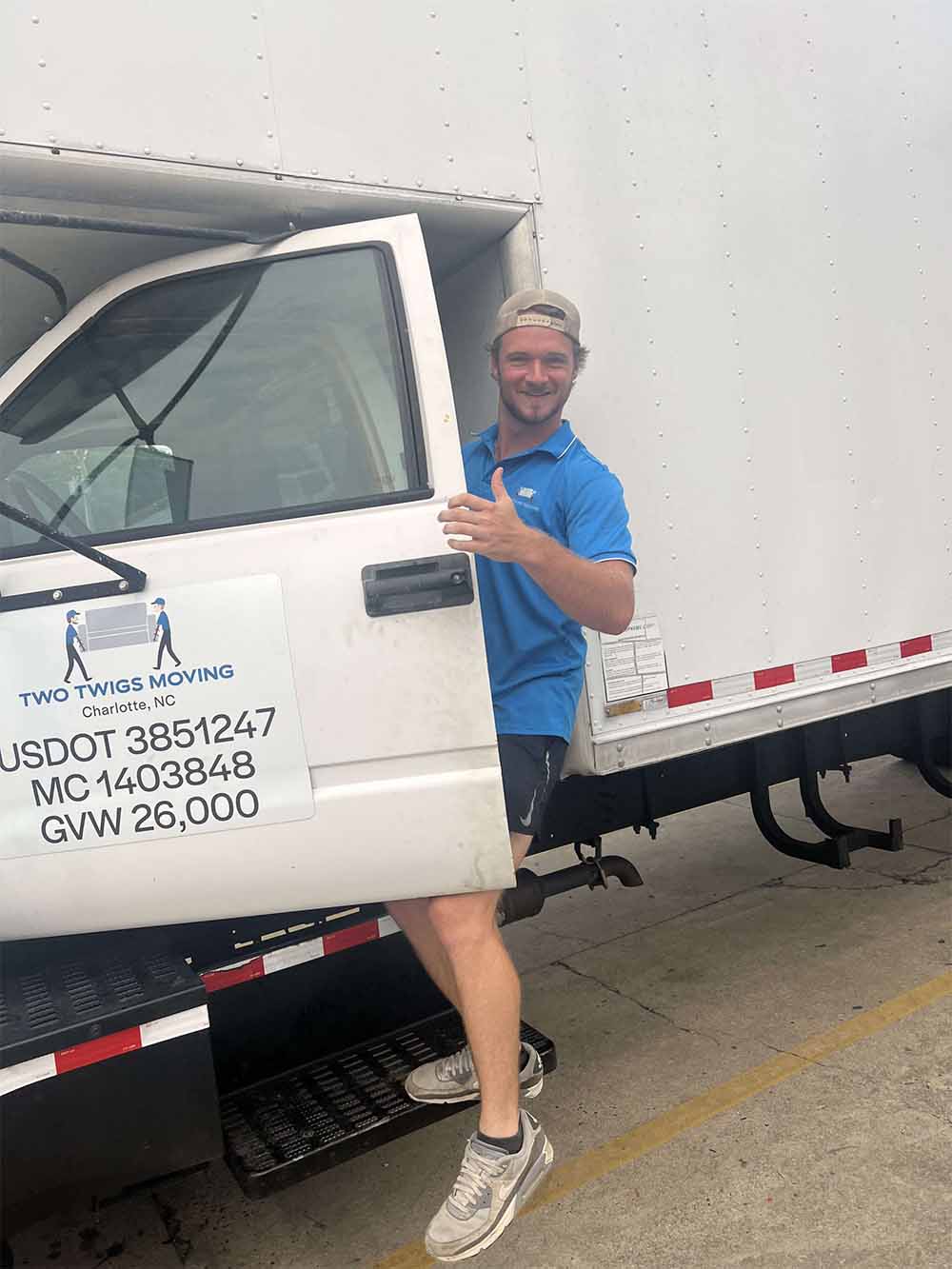Moving day can be stressful, but most common issues have straightforward solutions. Here’s how to tackle them:
- Running Out of Time to Pack: Focus on essentials, use alternative packing items (like suitcases or trash bags), and ask for help.
- Missing an Essentials Bag: Keep toiletries, clothes, tools, and documents in a clearly labeled bag with you.
- Parking or Elevator Issues: Reserve access in advance, follow building rules, and measure furniture to avoid surprises.
- Disorganized Packing: Label boxes by room, use an inventory list, and pack fragile items carefully.
- Furniture That Doesn’t Fit: Measure doorways and disassemble large items if needed.
For heavy lifting, use proper techniques and tools like dollies or straps. Consider hiring professional movers for convenience and safety, especially for complex moves. Whether you go DIY or hire experts, preparation is key to a smoother move.
Common Moving Day Problems and Quick Fixes
Even with the best planning, moving day can throw some unexpected challenges your way. Here’s a rundown of common issues and some practical solutions to keep things on track.
Running Out of Time to Pack
Feeling the crunch as the clock ticks down? It happens to the best of us, but here’s how to stay ahead of the game.
- Focus on essentials first. Pack the must-haves you’ll need right away – like toiletries, medications, chargers, and a change of clothes. You can deal with the less critical items later. As moving expert Alex Keight advises:
"Planning, preparation, and lists – lots of lists! – will make the process easier for you."
- Think outside the box (literally). If you run out of boxes, grab suitcases, laundry baskets, or even sturdy trash bags. Clothes can stay on hangers – just cover them with garbage bags for a quick and easy solution.
- Pack now, organize later. The priority is getting everything into containers. Use towels, blankets, and clothing to cushion fragile items instead of wasting time hunting for bubble wrap.
- Call for reinforcements. Whether it’s friends, family, or residential moving services, a few extra helping hands can make all the difference.
Once you’ve packed the essentials and secured your items, keep them easily accessible to avoid further delays.
Missing Your Moving Day Survival Kit
Realizing you’ve buried your essentials in one of many unmarked boxes can be a nightmare. Avoid this by planning ahead.
- Prepare a labeled essentials bag. Include toiletries, medications, chargers, snacks, important documents, and at least one change of clothes for each family member. Keep this bag with you instead of loading it onto the moving truck.
- Don’t overlook the tools. Scissors, a box cutter, markers, and trash bags are lifesavers during both the move and the unpacking process.
Parking and Elevator Access Problems
If you’re moving in an urban area, logistical hurdles like parking restrictions or elevator scheduling can slow you down.
- Book access ahead of time. Contact building management to reserve elevators and parking spots at both locations. Some buildings require 48–72 hours’ notice and may charge fees for exclusive use.
- Know the rules. Check for weight limits, time restrictions, or requirements like protective padding for elevators. Get these details in writing and share them with your movers.
- Measure everything. Make sure your largest furniture items will fit in the elevators or stairwells. If they won’t, arrange for disassembly beforehand.
- Pick off-peak hours. Moving during weekdays or less busy times can help you avoid competition for parking and elevator access.
Once you’ve handled the logistics, you’ll be better equipped to tackle the chaos of unpacking.
Messy Packing Without a Plan
Disorganized packing can make moving – and unpacking – a frustrating experience. A little planning goes a long way.
- Label and inventory everything. Write the contents and destination room on each box. Number your boxes and keep a basic inventory list. For extra clarity, use a color-coded system – blue for bedrooms, red for kitchens, green for living areas.
- Stick to one room at a time. Keep items from each room together instead of mixing them up. This will make unpacking much smoother.
- Get professional help for valuables. Fragile or high-value items like artwork, electronics, and antiques are best packed by professionals who use specialized materials to reduce the risk of damage.
Furniture That Won’t Fit
Nothing’s more stressful than realizing your couch or bed frame won’t fit through the door. Avoid this by planning ahead.
- Measure everything. Check the dimensions of doorways, hallways, stairwells, and rooms in your new place. Compare these measurements to your largest furniture pieces to ensure they’ll fit.
- Disassemble when needed. Many items, like bed frames and tables, can be taken apart to make transport easier. Label and bag any screws or hardware, and tape them to the corresponding piece.
- Hire the pros. For apartment moving, experienced movers can handle disassembly, maneuvering, and reassembly with the right tools and techniques.
With careful preparation, even the trickiest moving day problems can be managed smoothly.
Staying Safe and Avoiding Injuries
Moving day can be more hazardous than you might expect. In the U.S. alone, about 2 million back injuries occur each year, accounting for 20% of all workplace injuries. Of those, 75% happen during lifting tasks. You don’t want your move to be part of these statistics.
Before lifting anything, assess its weight and size. If it feels too heavy or awkward, don’t hesitate to ask for help. Clear your path of obstacles, plan your route, and do some light stretching to prepare your body. These simple steps can go a long way in preventing injuries.
When it comes to lifting, technique matters. Stand close to the object with your feet shoulder-width apart. Bend at your hips and knees, not your waist, while keeping your back straight. Hold the item close to your body – keeping it near your core reduces strain on your back. Most importantly, lift with your legs, not your back.
While carrying items, maintain proper posture by aligning your shoulders with your hips. Take small, controlled steps, and avoid rushing, even if you’re short on time. A good rule of thumb is to keep your "nose between your toes", which helps prevent twisting your torso while lifting. Instead of twisting, pivot with your feet to change direction. And always ensure your grip is secure – adjust immediately if something starts to slip.
Setting items down is just as important as picking them up. Reverse the lifting process: keep the load close to your body, maintain a straight back, and use your legs to lower it gently. Never drop or toss boxes, as this could damage your belongings and put unnecessary strain on your body.
Using the right tools can make a huge difference. Equipment like hand trucks, dollies, furniture sliders, and moving straps can take much of the physical burden off your body. For especially heavy items like refrigerators, washing machines, or large furniture, these tools are not just helpful – they’re essential.
If you’re working with others, communication is key. Assign one person to lead, synchronize your movements (e.g., count together: "one, two, three, lift"), and speak up if adjustments are needed. Don’t push through fatigue – take breaks when needed.
For particularly heavy or awkward items, it’s often best to call in professional movers. Residential moving services come equipped with the right training, tools, and insurance to handle these challenges safely. The peace of mind they provide can far outweigh the risks of attempting a DIY move.
Above all, prioritize your well-being. Take breaks, stay hydrated, and stop immediately if you feel pain. Your health is worth more than any shortcut.
sbb-itb-a5538b6
DIY Moving vs. Professional Moving Services
Once you’ve addressed safety for moving day, there’s still one big decision to make: should you handle the move yourself or bring in the pros? Each option has its own perks and challenges, and your choice can shape your overall experience.
DIY moving is often easier on your wallet upfront, but there are hidden costs and physical demands to consider. Think about the expenses for truck rentals, fuel, insurance, and supplies – they add up quickly. On top of that, you’re committing a lot of time and effort to packing, loading, driving, and unloading. It’s a hands-on approach that requires significant energy.
On the other hand, professional moving services come with a higher price tag, but they deliver value through expertise, proper equipment, and insurance coverage. These perks can help you avoid costly mistakes, injuries, and unexpected expenses. Plus, the convenience of having experienced movers handle the heavy lifting can’t be overstated.
Side-by-Side Comparison
Here’s a breakdown of how DIY moving stacks up against hiring professional movers:
| Factor | DIY Moving | Professional Moving |
|---|---|---|
| Cost | $100–$500 (local), $1,000–$3,000 (long-distance) | $800–$2,500 (local), $2,000–$8,000+ (long-distance) |
| Time Investment | Days to weeks of preparation and execution | Completed in just a few hours |
| Physical Demands | High risk of injury and exhaustion | Minimal physical effort required |
| Damage Risk | Higher chance of property and belongings damage | Professional handling reduces risk significantly |
| Convenience | Requires careful planning and significant effort | Full-service handling of all aspects |
If you’re on a tight budget, self-service moves can cost 20–50% less than full-service options. However, it’s important to factor in the time and physical effort required. For DIY moves, proper lifting techniques are a must to avoid injuries, as the process can be physically demanding.
DIY moving is a good fit for small, local moves, especially if you’re working with a limited budget or want full control over the process. But when it comes to larger households, long-distance moves, or tricky setups like stairs or elevators, professional movers are often the smarter choice. They’re also a lifesaver if you’re short on time or unable to manage the physical demands. For example, while DIY might work for small residential moves, professional help is often better for apartment moves or more complex scenarios like office relocations.
Conclusion
Moving doesn’t have to be a stressful ordeal. The secret to a smooth transition lies in preparation. Start planning four to eight weeks in advance by securing parking, reserving elevators, and packing an essentials bag with clearly labeled items. These simple steps can help you sidestep many common moving-day headaches.
When it comes to hiring movers, timing is everything. Booking a trustworthy moving company well in advance – especially in busy urban areas – can save you from last-minute scheduling issues. High demand for quality movers in cities like Charlotte, Charleston, or Greenville makes early reservations even more important.
If you’re moving within these areas, consider working with a local moving company that knows the ins and outs of the region. Professional movers familiar with local logistics, such as parking rules and building access, can handle these challenges with ease, ensuring your move runs smoothly. Their expertise can help you avoid the pitfalls that often come with DIY moves.
To stay in control of your move, research movers carefully. Verify credentials, get written agreements, and steer clear of companies requiring large upfront deposits. Whether it’s a residential move or an apartment relocation, partnering with experienced professionals not only reduces stress but also protects your belongings and saves time. By combining careful planning with expert help, you can make your moving day as seamless as possible.
FAQs
How can I save time and stay organized on moving day?
To make your moving day run smoothly and save time, it’s crucial to plan ahead. Start packing early and create a detailed schedule to keep everything on track. Focus on loading your essential items first, and assign clear tasks to everyone helping out to keep the process efficient.
Using labeled boxes can make a world of difference. Clear labeling and good communication ensure that nothing gets misplaced, and everyone knows what to do next. Staying organized and sticking to your plan can turn a chaotic day into a manageable one.
What are the best ways to keep my belongings safe and avoid injuries during a DIY move?
To keep your belongings safe and avoid injuries during a DIY move, preparation is everything. Start by using proper lifting techniques – always bend your knees and lift with your legs instead of straining your back. Make sure pathways are clear to prevent trips or falls, and rely on tools like dollies, straps, or furniture sliders to manage heavy or bulky items with ease.
For fragile items, pack them carefully with plenty of cushioning materials, and clearly label the boxes to minimize the chances of mishandling. Don’t overlook the importance of wearing sturdy shoes with good traction, and remember to take breaks when needed to avoid overexertion. Staying organized and putting safety first will help ensure the process goes as smoothly as possible.
When should I hire professional movers instead of moving on my own?
Hiring professional movers can be a smart decision when you want to save time, avoid physical exhaustion, and ensure your belongings are handled with care. This is particularly important for long-distance moves, large households, or situations involving heavy furniture or delicate items that need special handling or equipment.
Professional movers offer expertise, efficiency, and insurance protection, giving you peace of mind during what can be a stressful process. While doing it yourself might appear cheaper at first glance, the convenience and reduced risk of damage often make hiring movers a worthwhile choice, especially for more complicated relocations.


.svg)


